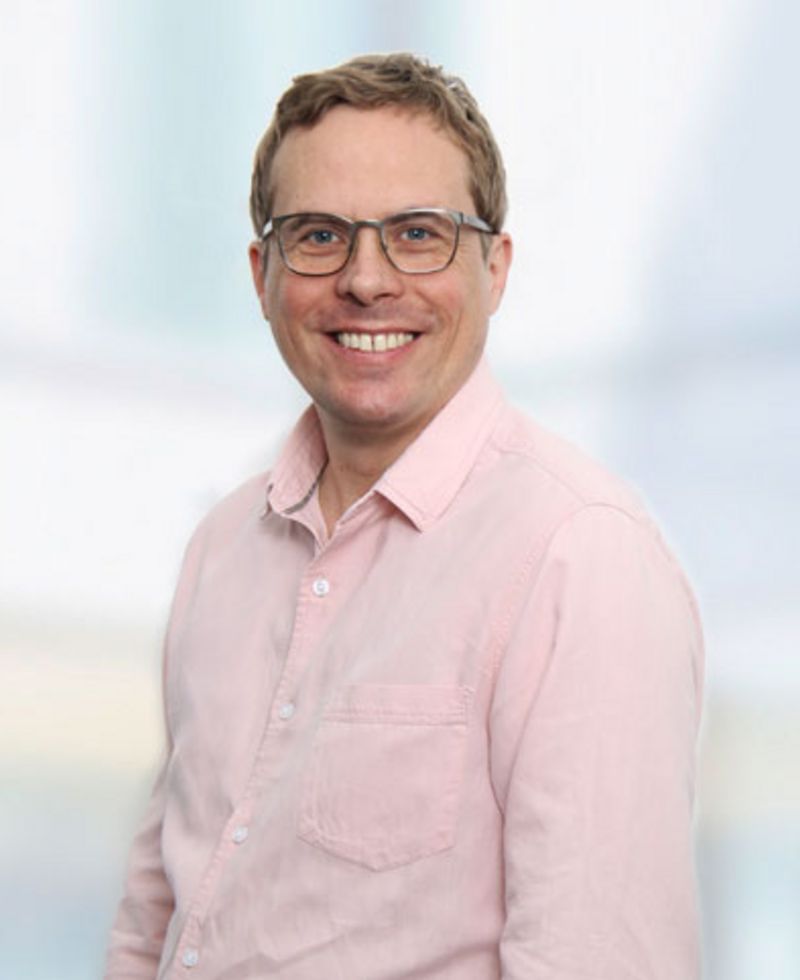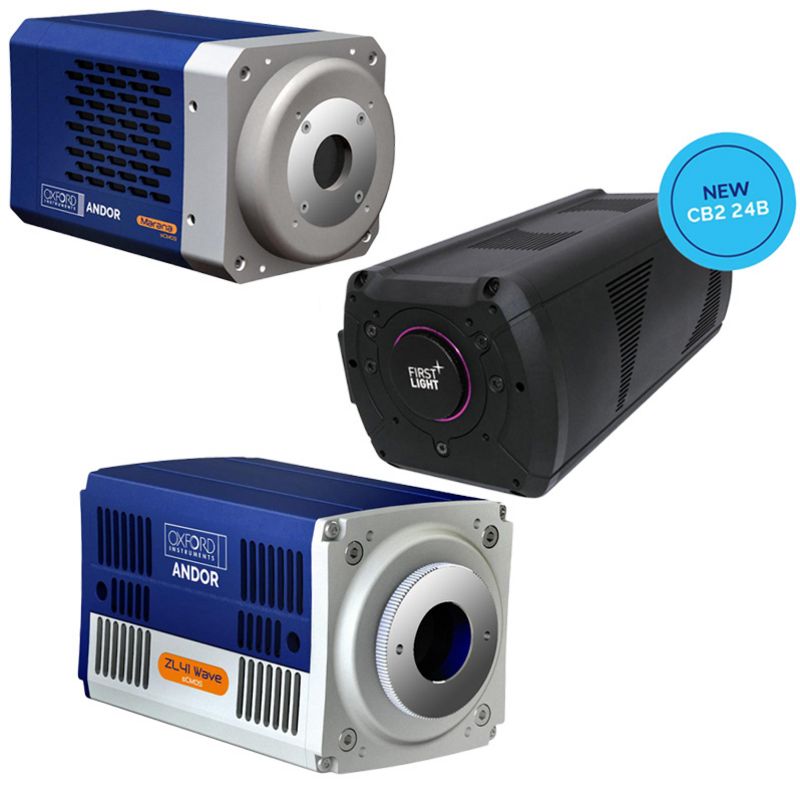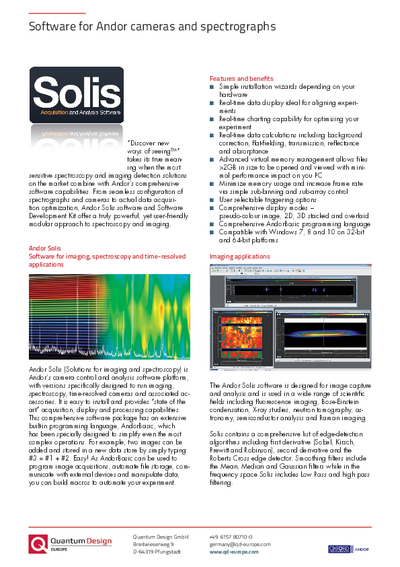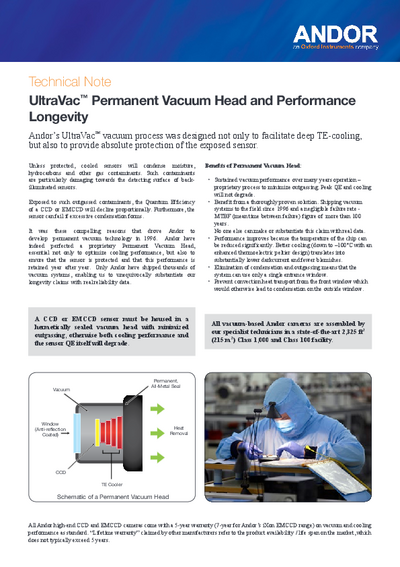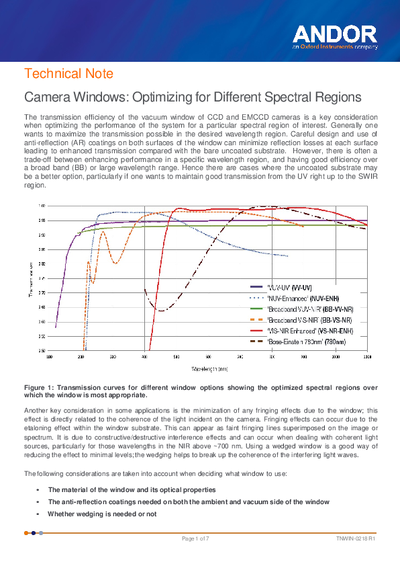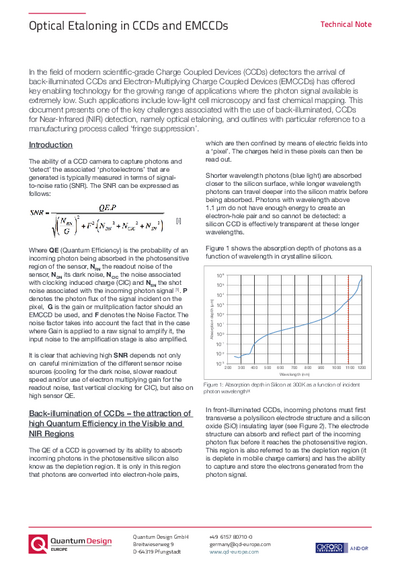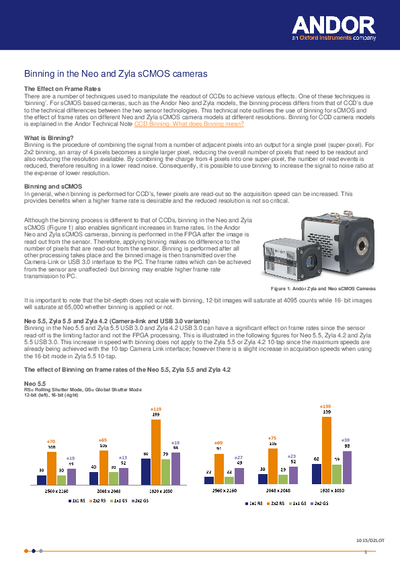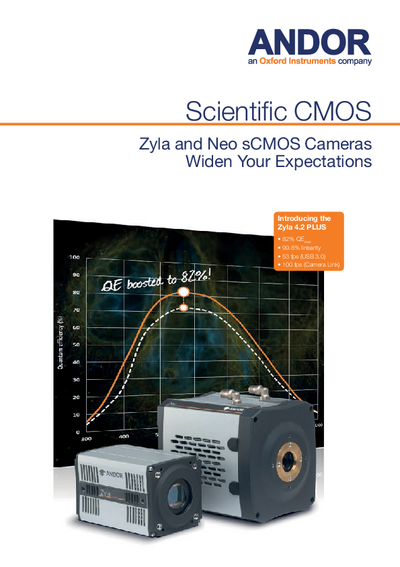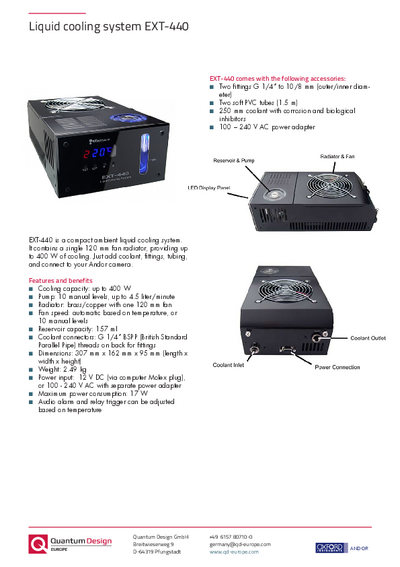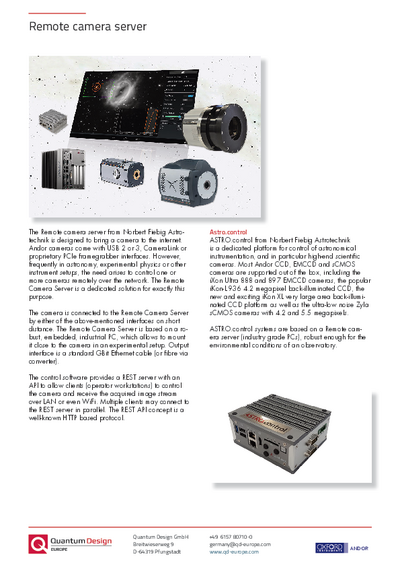sCMOS cameras for physical sciences
Marana, CB2 and ZL41 Wave from Oxford Instruments AndorThe Marana, CB2, and ZL41 Wave sCMOS cameras represent a significant advancement of the well-established CMOS technology for scientific applications. Thanks to their unique characteristics, they are well suited for a wide range of quantitative measurement tasks in physics and astronomy.
All Andor sCMOS cameras offer extremely low noise and high sensitivity, enabling them to deliver superior image quality—often even outperforming EMCCD cameras under low-light conditions.
The sensor in the Marana camera is housed in a vacuum enclosure and can be cooled to an industry-leading temperature of -45 °C. This allows its use in the most demanding applications.
In addition to conventional imaging, the Marana and ZL41 Wave sCMOS cameras are also ideal for high-speed spectroscopy, particularly for multi-track and hyperspectral imaging. The CB2 model delivers the highest resolution with 24 megapixels, while still achieving impressive frame rates.
- Extremely low read noise of 0.9 electrons (lower detection limit than any CCD camera)
- High resolution from 4.2 to 24 megapixels with pixel sizes from 2.74 µm to 12 µm
- Fast frame rates up to 101 frames/s at full resolution
- High dynamic range up to 53,000 : 1
Further information
The Marana, CB2, and ZL41 Wave sCMOS cameras deliver outstanding performance for scientific imaging tasks. Combining high resolution, ultra-low noise, and fast frame rates, these advanced scientific CMOS cameras are ideal for time-critical and light-sensitive experiments.
With a vacuum-cooled design and embedded FPGA-based processing, the Marana sCMOS camera maximizes sensitivity and image stability. It excels in low-light imaging and is optimized for applications requiring long exposures and uncompromised image quality.
The CB2 camera is equipped with a state-of-the-art 24-megapixel back-illuminated sensor, offering an exceptionally wide field of view and global shutter technology. It supports up to 37 full-resolution frames per second, with a read noise of just 1.3 electrons, and provides on-chip 2×2 binning without increasing noise—significantly extending dynamic range. Despite its large sensor size (19.3 mm diagonal), the CB2 remains compatible with C-mount optics, and a TFL mount is available upon request.
Both the Marana and CB2 employ back-illuminated sensor technology, achieving quantum efficiencies of >70% and up to 95%, respectively. A UV-transparent window option is available for enhanced UV sensitivity.
The ZL41 Wave camera is ideally suited for experiments that demand both speed and sensitivity. It delivers sustained performance of up to 101 frames per second via CameraLink—and even faster with sub-image readout—while achieving read noise levels as low as 0.9 electrons. Its dark noise suppression technology ensures consistently low noise across a wide range of exposure conditions.
For added flexibility, the ZL41 Wave also features a USB 3.0 interface, offering up to 53 frames per second at 4.2-megapixel resolution. With its exceptional balance of performance and ease of integration, the ZL41 Wave redefines the concept of a versatile, high-performance scientific camera—making it a strong alternative to interline CCDs.
The camera supports both rolling and global (snapshot) exposure modes. The latter enables true freeze-frame capture, emulating the performance of interline transfer CCDs, using its 5.5-megapixel sensor.
Specifications
|
| Marana 4.2B-11 | Marana 4.2B-6 | ZL41 Wave 5.5 / 4.2 | CB2 |
| Resolution | 2048 x 2048 x 11 µm | 2048 x 2048 x 6.5 µm | 2560 x 2160 x 6.5 µm/ | 5328 x 4608 x 2.74 µm |
| Sensor Diagonal | 31.9. mm | 18.8 mm | 21.8 mm / 18.8 mm | 19.3 mm |
| Quantum Efficiency | 95 % | 94 % | 64 % / 82 % | 74 % |
| Read Noise | 1.6 e- | 1.1 e- | 0.9 e- | 1.3 e- |
| Sensor-Temperature | -45 °C | -45 °C | 0 °C or -10 °C | -20 °C |
| Dark Current e-/pixel/s | 0.3 | 0.1 | 0.1 or 0.019 | 0.0015 |
| Cooling | Air and water | Air and water | Air or water | Air or water |
| Dynamic Range | 53,000 : 1 | 26,000 : 1 | 33,000 : 1 | 39,000 : 1 |
| Linearity | >99.7 % | >99.7 % | >99.8 % |
|
| PRNU (Photon Response Non-Uniformity) | <0.5 % | <0.5 % | <0.01 % |
|
| Shutter | Rolling | Rolling | Rolling and/or Global | Global |
| Interface | USB 3.0 | USB 3.0 / CoaXPress | USB 3.0 or 10-tap CameraLink | CXP-12 or 10 GigE (Eth or optical) |
| Full Frame Rate at Full Resolution | 48 | 43 / 74 | 100 fps | 74 fps |
Watch the videos about key specifications and typical applications.
Applications
Downloads
Videos
Reference customers
| Title | Author(s) | Institute | Year | Detector / Spectrograph |
|---|---|---|---|---|
| Microsopy | ||||
| Microscopy of LEDs and phosphors in practical exercises for students | S. Bock, D. Berben | Department of Electrical Engineering and Information Technology, South Westphalia University of Applied Sciences, Hagen, Germany | 2017 | Neo-5.5-CL3 |
| Fluorescence microscopy of semiconductor nanowire arrays | S. Rahimzadeh-Kalaleh Rodriguez1, D. van Dam2, J. Gomez Rivas1,2 | 1Surface Photonics, AMOLF, c/o Philips Research Laboratories, Eindhoven, The Netherlands 2COBRA Research Institute, Eindhoven University of Technology, The Netherlands | 2014 | Neo DC152 QC-FI1 |
| Detection of electrochemically generated peroxide and superoxide by fluorescence microscopy | C. Dosche, S. Dongmo | Institute of Chemistry, University of Oldenburg, Germany | 2013 | Neo DC152 QC-FI1 |
| Imaging with scintillation screens | ||||
| Field ion microscopy of electron emitters | P. Groß, A. Schröder, C. Lienau, S. Schäfer | Institute for Physics, Carl von Ossietzky University Oldenburg, Germany | 2019 | Neo-5.5-CL3 |
| Phase transitions in 1T-TaS2 mapped by ultrafast LEED | S. Vogelgesang, G. Storeck, S. Schäfer, C. Ropers | IV. Physical Institute, Georg-August-University, Göttingen, Germany | 2017 | Zyla-5.5-CL10 |
| Application of the sCMOS camera Andor Neo for X-ray and neutron imaging | N. Kardjilov1, S. Williams1,2, F. Wieder1, A. Hilger1, I. Manke1 | 1Helmholtz-Zentrum-Berlin, Berlin, Germany 2Johns Hopkins University, Baltimore, USA | 2014 | Neo DC152-QF-FI3 |
| Polarization dependent photoelectron emission with high lateral resolution | T. Wagner | Institute of Experimental Physics, University of Linz, Austria | 2012 | Neo DC152-QC-FI1 |
| Quantum physics | ||||
| Silicon-vacancy color centers in n-type diamond | A. M. Flatae, F. Sledz, M. Agio | Laboratory of Nano-Optics and Cμ, University of Siegen, Germany | 2020 | Zyla-4.2P-USB3-W |
| T. Lompe | Institute of Laser Physics, Quantum Matter Group,University of Hamburg, Germany | 2019 | Zyla-5.5-USB3 | |
| Real- and momentum-space imaging of plasmonic waveguide arrays | F. Bleckmann, S. Linden | Physikalisches Institut, | 2016 | Zyla-5.5-USB3 |
| Plasma and fusion research | ||||
| Evaluation of the Zyla sCMOS imaging camera for IMSE diagnostic | O. P. Ford, C. Biedermann | Wendelstein 7-X, Max Planck Institute for Plasma Physics, Greifswald, Germany | 2014 | Zyla-5.5-CL10 |
| Measuring ion temperatures and helium densities in the hot core of a nuclear fusion reactor using sCMOS and EMCCD cameras | R. J. E. Jaspers | Department of Applied Physics, Eindhoven University of Technology, The Netherlands | 2014 | Neo DC152 QC-FI1 |
| Real-time characterization of plasma evolution by diffraction imaging | N. K. Rothe, A. V. Svanidze, C. Schuster, M. Lütgens, S. Lochbrunner | Institute of Physics, University of Rostock, Germany | 2013 | Neo DC152 QC-FI1 |
| Astronomy | ||||
| High-speed photometry with the Marana sCMOS camera at the Planetary Transit Study Telescope | P. Ioannidis, J.H.M.M. Schmitt | Hamburg Observatory, Physics Department, University of Hamburg, Germany | 2020 | Marana-4BV11 |
| Testing an Andor Marana sCMOS camera for high-speed astronomical image acquisition | M. Risch1 | 1 Planetarium, Mammendorf, Germany 2 PlaneWave Instruments, Adrian, MI, USA | 2020 | Marana-4BV6U |
| High-speed imaging and its applications: Beating down the scintillation noise | P. Ioannidis, J.H.M.M. Schmitt | Hamburg Observatory, Physics Department, University of Hamburg, Germany | 2017 | Zyla-4.2-CL10 Neo-5.5-CL3 |
| Active optical debris detection: Highly accurate position determination of space debris orbits | W. Riede, D. Hampf, P. Wagner, L. Humbert, F. Sproll, A. Giesen, | Institute of Technical Physics, Deutsches Zentrum für Luft- und Raumfahrt (DLR), Stuttgart, Germany | 2016 | Zyla-5.5-CL10 |
| Nonlinear optics | ||||
| Imaging through nonlinear metalenses for second harmonic generation | C. Schlickriede, T. Zentgraf | Department of Physics, Paderborn University, Paderborn, Germany | 2020 | Zyla-5.5-USB3 |
| Shot-resolved sensitive detection of high harmonics generated by bright quantum light | A. Rasputnyi, M. Chekhova | Max-Planck Institute for the Science of Light, Erlangen, Germany | 2025 | Marana-4BV6U |
| Particle image velocimetry (PIV) and particle tracking velocimetry (PTV) | ||||
| Redesign of a 3D PTV system with ANDOR’s Neo sCMOS | P. Steinhoff, M. Schmidt, D. Müller | E.ON Energy Research Center, Institute for Energy Efficient Buildings and Indoor Climate (EBC), RWTH Aachen University, Germany | 2013 | Neo DC152 QFR-FI2 |
| Spectroscopy | ||||
| Photoluminescence spectroscopy of metal nanoantennas coupled to the atomically thin semiconductor WS2 | J. Kern, R. Bratschitsch | Institute of Physics and Center for Nanotechnology, University of Münster, Germany | 2015 | Neo-5.5-CL3 |
| Using a surface-forces-apparatus to measure force-distance profiles across confined ionic liquids | T. Utzig, H.-W. Cheng, M. Valtiner | Department of Interface Chemistry and Surface Engineering, Max-Planck-Institut für Eisenforschung, Düsseldorf, Germany | 2014 | Zyla-5.5-CL3 |
Remarks:
1New part number of DC152 QC-FI: Neo-5.5-CL3
2Neo DC152 QFR-FI replaced by Neo-5.5-CL3-F
3New part number of DC152 QF-Fi: Neo-5.5-CL3-F
Contact
| +49 6157 80710-690 | |
| +49 6157 807109690 | |
| Write e-mail |
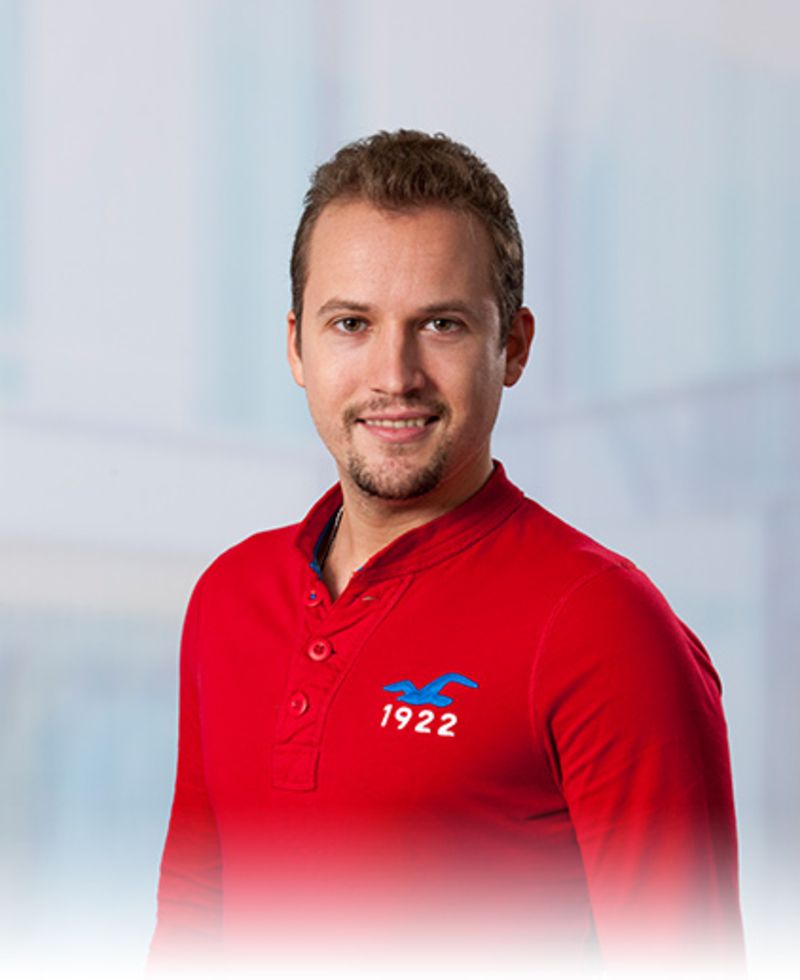
| +49 6157 80710-692 | |
| +49 6157 807109692 | |
| Write e-mail |

| +49 6157 80710-754 | |
| +49 6157 807109754 | |
| Write e-mail |
